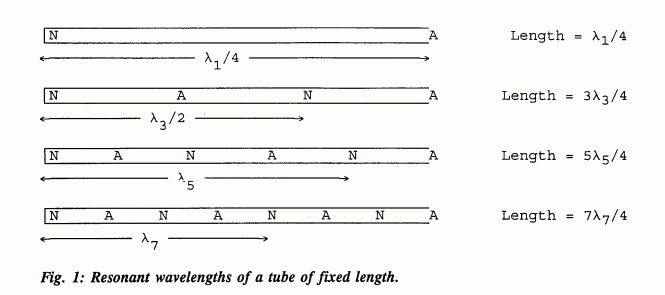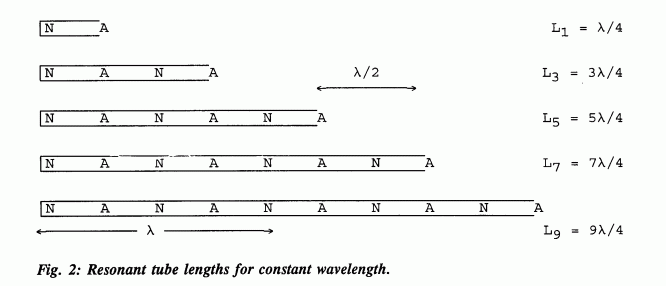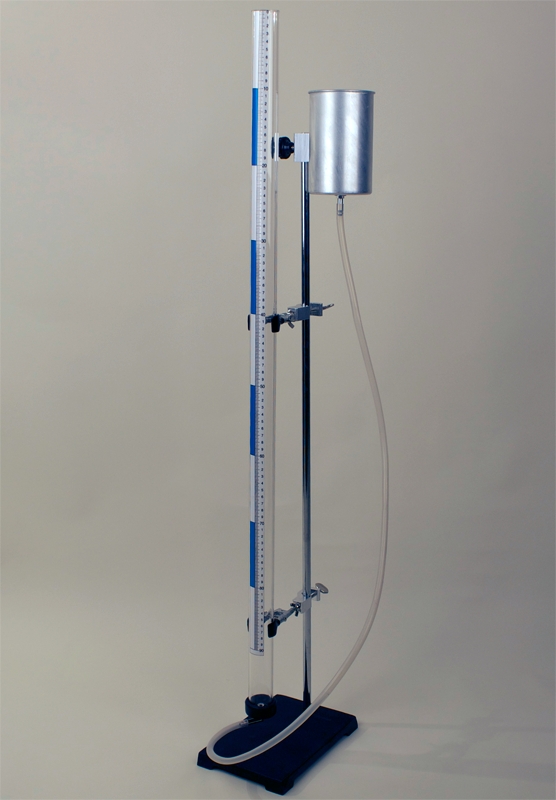W-1 SPEED OF SOUND
(Resonance Method)
1. PURPOSE:
To determine the speed of sound in air.
2. APPARATUS:
Resonance tube, assorted tuning forks, rubber bands, striking block, water.
3. THEORY:
(1) The frequency of sound in a medium is related to the wavelength by the formula v = fλ where v is the speed of sound in the medium, f is the frequency of the sound, and λ (Greek letter "lambda") represents the wavelength of the sound in the medium. This formula is used to calculate the speed of sound in air from measurements of wavelength and frequency.
(2) The sound speed varies with temperature. At 0°C the speed in air is 331.4 m/sec, while at 20°C it is 344 m/sec. The speed is very nearly linearly dependent on temperature. Use this information to write an equation for speed of sound as a function of temperature.
(3) RESONANCE. When a vibrating object sets up air vibrations in an enclosed space, the sound vibrations in the air are very weak at some frequencies, and strong at other frequencies. The frequencies at which the sound vibrations are strong are called resonant frequencies of the system, and these are easily recognized by listening to the sound intensity. Altering the shape or size of the enclosed volume will give a different set of resonant frequencies.
Resonance occurs because the walls of the enclosure restrict the ways in which the air inside can vibrate. Each of the ways it can vibrate is called a mode of vibration. The number of different modes of any container is infinite, but there are not allowed modes for every frequency.
When the air within an enclosure is set into periodic vibration, the values of many measurable quantities change periodically with time. Such quantities as particle position, velocity, pressure, density, and even temperature vary periodically. The average size of the variation of any one quantity is different in different parts of the medium. There may be certain points in the medium where a particular quantity is not varying at all. Such a region is called a node of that quantity. A region where the variation of a quantity has a relative maximum is called an antinode of that quantity. (1)
In long tubes, there will always be a particle velocity node at a closed end, since the closure prevents air motion. There will be a particle velocity antinode near an open end. In any tube, the spacing between a node and the next closest antinode is always 1/4 of the wavelength of the sound.
A tube of given length may vibrate in an unlimited number of ways, some of which are illustrated in Fig. 1. These differ in the number of nodes and antinodes within the tube, and therefore have different wavelengths and frequencies.
A tube, string or rod is, to a first approximation, a one-dimensional vibrating body, its resonant frequencies determined primarily by its length. A tuning fork may be thought of as such a rod, bent at its center and clamped at its center. Thus the center of the fork has a node, and its ends antinodes.


In this experiment a tuning fork is used to set up a sound wave of fixed wavelength within the tube. The tube length is then varied until sound resonance occurs at that wavelength. Fig. 2 shows several resonant situations with a fixed wavelength. The shortest length which produces resonance is approximately on fourth of the wavelength. Fig. 2 shows that the resonant tube lengths differ by one-half wavelength, so if several resonant lengths are determined, their differences give a measurement of λ/2, and from this the speed of sound may be calculated.
4. APPARATUS:

Fig. 3 shows a concentric tube apparatus. The outer tube is closed at the bottom and filled with water. The inner tube may be freely moved up and down so that it acts as a resonant tube, its bottom being "closed" by the water surface. The resonant length may be easily changed by moving it up and down.
|
Fig. 4 shows a commercial resonant tube apparatus. The resonant tube on the right is made of glass. The water level is raised and lowered within the resonant tube by raising or lowering the water reservoir (on the right). The two are connected by a flexible rubber hose.
5. PROCEDURE:
(1) Strike a tuning fork against a soft material such as a rubber block. Hold the vibrating fork near the open end of the resonant tube and listen to the sound intensity as the water level is raised or lowered. When a position of maximum sound intensity is found, record the position of the water level on the tube scale or with a meter stick. The scale reads from zero at the top, so this directly gives the length of the resonant air column. There may be 2, 3, or more resonant lengths for each tuning fork. Find them all.
(2) Check the data for consistency. The spacing between the resonant lengths should be about equal, and this spacing should be twice the length of the shortest tube length. If this is not the case, you probably recorded faint resonances due to tuning fork overtones. Note these unwanted values in your data sheet, but do not erase or destroy any data.
(3) Repeat procedure (1) and (2) for a fork of different frequency.
(4) Measure the inside diameter of the tube.
(5) Record the room temperature.
6. CALCULATIONS:
(1) Calculate the wavelength by the method described, using all of the data from all forks to obtain the average speed of sound in the resonant tube.
(2) Does your data show any evidence that the speed of sound is frequency dependent?
(3) The speed of sound varies with temperature. At 0°C the speed in air is 331.4 m/sec, while at 20°C it is 344 m/sec. The increase in speed is nearly linearly dependent on temperature. Use this information to write an equation for speed of sound as a function of temperature.
(4) Use the equation you constructed in the previous step to correct your experimental value the speed of sound to 0°C. Compare with the "accepted" value. Is this difference simply due to experimental error, or is there a reason why your value should be different?
(5) Considering the data uncertainties and scatter of the results, assign a reasonable percent error to your experimentally determined speed of sound.
(6) You probably noticed that the shortest resonant tube length is not exactly one fourth of the wavelength. This is because the antinode does not lie exactly at the end of the resonant tube. It is above the end of the tube, a distance equal to about 1/3 of the tube diameter. Use this fact to check whether the distance between this antinode and the next node is one fourth of the wavelength.
(7) As you know, the harmonics of a vibrating body have frequencies 2, 3, 4, etc. times the frequency of the fundamental. If you noticed any resonances due to harmonics of the tuning forks, calculate which harmonics they were. Would you expect to find the second harmonic? The third?
(8) Some harmonics of the air column cannot be caused to resonate? Which are they? Why can't they resonate?
(9) Make a good estimate (calculation) of the speed of sound in the metal of each tuning fork. If you didn't measure the length of the fork tines, estimate it from memory. A good scientist must not only be a good observer, but must have a good observational memory. Of what metal was each fork made?

Text and figures © 1997, 2004 by Donald E. Simanek
1. In this experiment, when we discuss air columns we will refer to the speed of the air. There is a velocity node at a closed end and an antinode at an open end. If we were interested in pressure, we would say there is a pressure node at the open end, an antinode at the closed end. Always be clear which quantity you mean.
